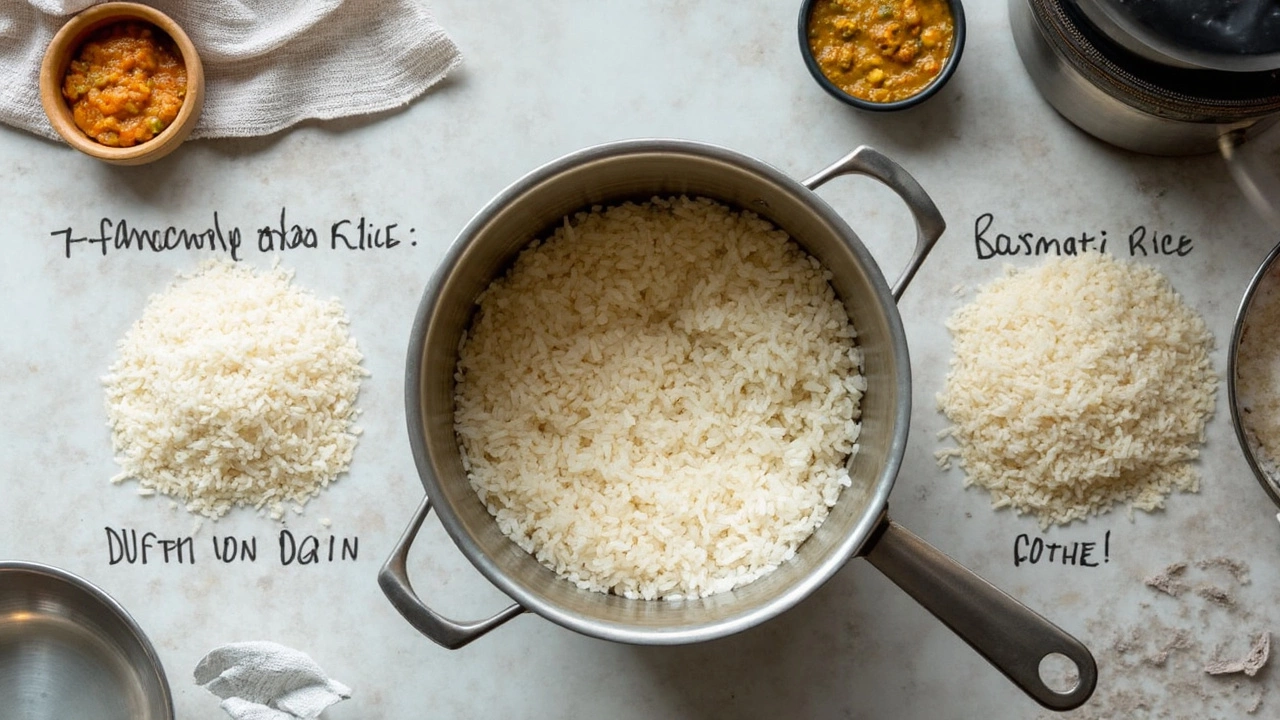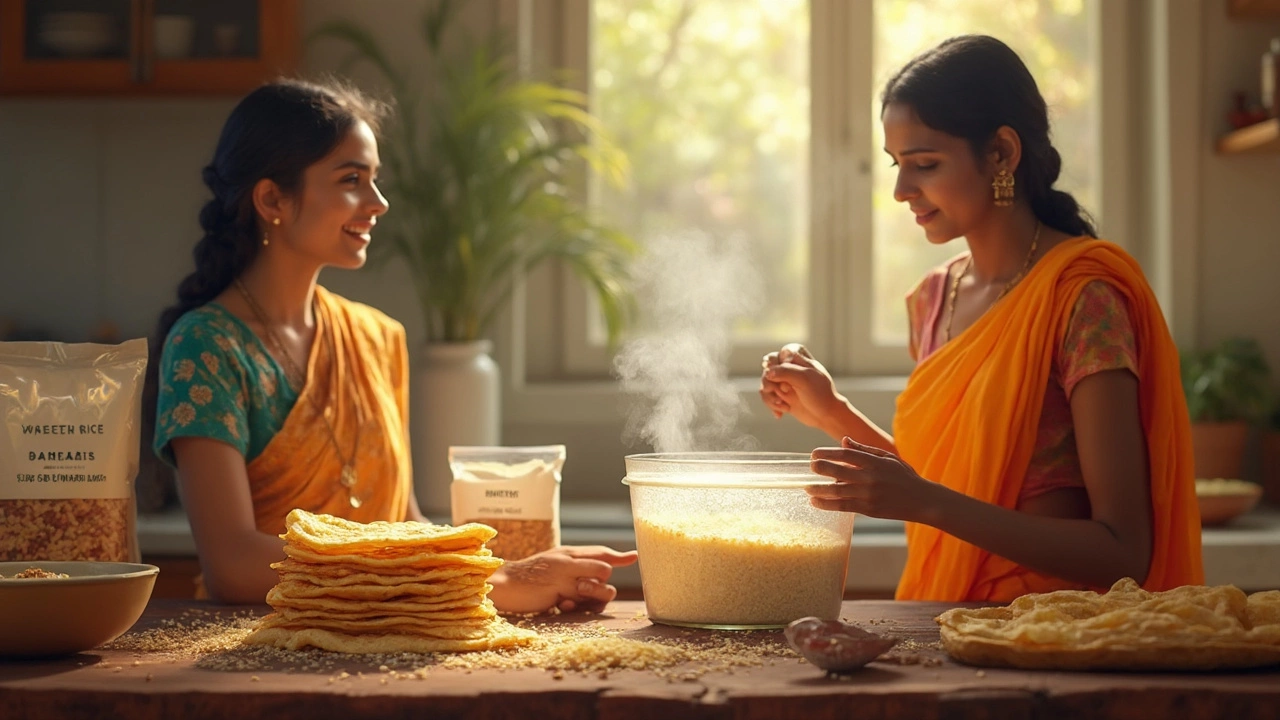Finding the right rice for dosa batter in the US can feel way more complicated than it should be. Walk down any regular grocery store aisle and you’ll see a dozen different bags of rice—none of them labeled 'dosa rice.' So, how do you pick the one that won’t ruin your batter dreams?
Here’s the funny thing: in India, traditional dosa uses parboiled rice called “idli rice.” You don’t usually find that exact type at American supermarkets, but that doesn’t mean good dosa is out of reach. What matters most is the texture and structure of the rice you choose, not the brand printed on the bag.
Want light and crisp dosas? Skip long-grain Basmati. Short-grain rice (like the kind used for sushi, or Calrose) actually gets you closer to classic dosas than you’d expect. If you’re hitting an Asian, Korean, or Latino market, look for bags labeled 'medium' or 'short grain.' Parboiled rice (sold as Uncle Ben’s or Golden Sella) is another handy pick, and a mix of both often gives the best of both worlds.
Don’t get overwhelmed by labels like 'Jasmine,' 'Arborio,' or 'Sticky'. Just remember: steer clear of aromatic or super sticky varieties, and go for plump grains that cook soft but not mushy. A little trial and error is totally normal, but with these pointers, your dosa game will level up fast.
- Why Rice Choice Matters for Dosa Batter
- Best Rice Varieties Available in the USA
- Rice Substitutes and Blends
- Tips for Perfect Dosa Batter Every Time
Why Rice Choice Matters for Dosa Batter
The kind of rice you pick for dosa batter is a bigger deal than most people think. It’s not just about what’s cheap or available—the rice decides the texture, color, and how crisp or soft your dosas end up. If you go with the wrong type, your dosas might turn out chewy, bland, or just plain disappointing.
Traditional dosa in South India is made using parboiled or 'idli rice,' which soaks up water well and grinds down to a grainy, fluffy texture. This unique texture is what gives dosas their crispy edges and those little holes on the surface, which everyone loves. In the US, that exact kind of rice is hard to find, so knowing what to look for really helps.
If you use long-grain rice like Basmati, you might get dosas that are too stiff and dry. Super sticky rice can make your batter too gooey, which means soft, soggy dosas instead of crispy ones. Medium or short grain rice usually finds the sweet spot. The right rice soaks and ferments just enough to get tangy batter with a pillow-y inside and a thin, crisp shell.
Check out how different rice types stack up for dosa:
| Rice Type | Texture Outcome | Fermentation |
|---|---|---|
| Parboiled/Idli Rice | Light, crisp, and porous | Excellent |
| Short Grain (Calrose/Sushi rice) | Crispy, close to traditional | Very Good |
| Medium Grain (Japonica) | Balanced—slightly chewy | Good |
| Long Grain (Basmati/Jasmine) | Dry, less crispy | Poor |
| Sticky/Sweet Rice | Too soft and dense | Poor |
The rice you pick has a direct impact on the fermentation process too. Short and medium grain rice has more starch, helping good bacteria do their job and giving you a nicely fermented, slightly sour dosa batter. That’s the secret to the flavor you get at your favorite South Indian restaurant.
If making dosa is something you do often, it’s worth watching what works for you and sticking with it. Even in the same store, rice brands can change their quality batch to batch. Trust your experience, but if you’re new, using short-grain Calrose or parboiled rice in your dosa batter is usually a safe bet.
Best Rice Varieties Available in the USA
Let’s talk about what’s on actual store shelves. The search for good dosa batter in the US almost always comes down to working with what you’ve got in local stores. You won’t usually spot anything called “dosa rice,” but you still have some solid choices to help you nail that dosa batter.
Here are the kinds of rice that work best for dosa when you're shopping in the US:
- Parboiled Rice (sometimes called Converted Rice): Check brands like Uncle Ben’s, which you’ll find almost anywhere. Indian stores carry South Indian brands labeled "idli rice" or "parboiled rice," which honestly do the job just like in India.
- Medium or Short-Grain Rice (like Calrose): This is easy to find at big grocery stores and Asian markets. Sushi rice also falls in this category. It soaks and grinds well, always a bonus for batter.
- Sona Masoori: If you have access to an Indian grocery, pick up Sona Masoori. It’s super popular for dosa and idli. The grains are medium-sized, making it a top choice for many home cooks.
- Blended Rice: Some people blend parboiled rice with short-grain rice (50/50 or 60/40) to get a batter that spreads easier and ferments well. This mix brings out crisp yet airy dosas.
"In the US, parboiled rice—often sold as 'idli rice' in Indian markets—gives the best traditional dosa results, but Calrose and Sona Masoori can make superb dosas too." — Swasthi Shreekanth, Swasthi’s Recipes
For comparison, check out the common US market options and how they work for dosa:
| Rice Type | Where to Find | Texture Outcome | Notes |
|---|---|---|---|
| Parboiled (Idli) Rice | Indian grocery, some chain stores | Crispy, authentic, ferments well | Closest to traditional dosa |
| Calrose (Medium/Short-Grain) | Major supermarkets, Asian stores | Soft inside, crisp outside | Affordable, easily available |
| Sona Masoori | Indian grocery | Light, crisp, slightly chewy | Very popular for dosa |
| Basmati (Long-Grain) | Everywhere | Tends to be dry, cracks | Not recommended for dosa |
The big thing: skip Basmati. Its long grain isn’t starchy enough for that perfect dosa. If you see Jasmine or Arborio rice, leave those on the shelf; they don’t give reliable results. Calrose or parboiled rice is the safest bet. If you’re choosing between blends, use a little more parboiled in the mix for classic flavor and texture.

Rice Substitutes and Blends
Let’s be real: not everyone lives near an Indian grocery. Luckily, you’ve got choices when it comes to making dosa batter with rice found in US stores. The real goal is to get that golden, crisp texture on the outside and a little bit of chew inside—so here’s what actually works.
If you don’t find parboiled rice or authentic 'idli' rice, don’t panic. There are combos and substitutions that come shockingly close to the real thing. Here’s what a lot of home cooks use:
- Calrose Rice + Parboiled Rice Mix: This is a favorite because Calrose is a short/medium grain easily available in most supermarkets, while parboiled rice adds the strength needed for crispness.
- Sushi Rice: Sounds odd, but sushi rice is a solid substitute if you use it with 20-30% parboiled rice. It’s non-aromatic, sticky but not too sticky, and gives a nice balance.
- Jasmine or Long-Grain White Rice: These aren’t top choices—they make dosas thinner and less chewy. But if that’s all you have, mixing them half-and-half with parboiled rice still works for a decent outcome.
- Idli Rava: Not exactly a rice, but this cracked rice product speeds up soaking and removes the need for a powerful blender. Replace half the rice with idli rava for quick prep.
Here’s a side-by-side table to make it super clear which blends work best for dosa in the US:
| Rice Blend | Texture Outcome | Availability | Ease of Fermentation |
|---|---|---|---|
| Calrose + Parboiled (50/50) | Crisp, lacy, chewy | High (any supermarket) | Ferments easily |
| Sushi Rice + Parboiled (70/30) | Smooth, slightly thicker, crisp edges | High (Asian markets) | Good fermentation |
| Long-Grain + Parboiled (50/50) | Thinner, less chewy | Very high (regular stores) | Ferments fine, less puff |
| Idli Rava + Parboiled (50/50) | Classic, authentic taste | Available at Indian stores | Best fermentation |
If you’re blending at home, remember: always rinse your rice several times to remove excess starch, and soak for at least 4 hours to help fermentation. For blending, a high-powered blender is great, but any regular blender might need a little more water and patience. Don’t get stuck chasing the exact brand—focus on short/medium grain blends and parboiled rice in a 1:1 ratio for the best results you can get outside India.
Tips for Perfect Dosa Batter Every Time
If you want dosa that looks and tastes like the real deal, getting your batter right is where it all begins. The dosa batter can make or break your breakfast. Here’s what actually matters.
- Soak with care: Soak your rice and urad dal separately for at least 6 hours. Use room-temp water. Cold water slows things down, and soaking less than 6 hours makes your batter grainy.
- Grind for the right texture: Don’t rush this step. A high-powered blender or wet grinder gets your batter smooth and fluffy. Keep the ratio at about 3 parts rice to 1 part urad dal by volume.
- Ferment smart: Cover the bowl, set it in a warm spot for 8–12 hours. If your house is chilly, try the oven with just the light on, or stash the bowl in your Instant Pot on the yogurt setting with the lid ajar.
- Salt timing: Add salt after fermentation for better rising. Adding it early can actually slow things down.
- Water checks: The batter should flow but not be watery—think pancake batter, just a touch thinner. Add water bit by bit when grinding; you can always add more before making dosas.
Stuck in a rush? Fast-track your fermentation on cold days with a pinch of fenugreek seeds while soaking. They boost both flavor and fermentation (plus, fenugreek gives that subtle South Indian kick).
| Problem | Likely Cause | Fix |
|---|---|---|
| Batter won't rise | Too cold or underripe dal | Ferment longer or try a warmer location |
| Flat or dense dosas | Batter too thick/not enough fermentation | Thin batter slightly, ferment for a few more hours |
| Sour taste | Over-fermentation | Ferment for less time next round, or move to fridge once bubbly |
And here’s a tip few mention: blend a handful of cooked rice into the batter before fermentation—this actually helps dosas turn golden and crisp on the pan, just like your favorite restaurant. After a batch or two, you’ll have your own rhythm, and the dosa batter process won’t feel mysterious or intimidating at all.
